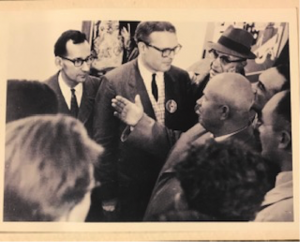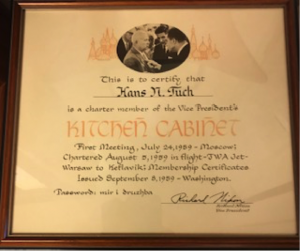by Hans Tuch
Editor’s note: Between 1959-1991, the U.S. Information Agency mounted a series of exhibitions in the Soviet Union featuring various aspects of American life and culture. The 1959 American National Exhibition in Moscow, best known for the famous “kitchen debate” between Vice President Richard Nixon and Soviet Premier Nikita Krushchev, was visited by 2.7 million Soviets. USIA officer Hans Tuch recounts some of the interaction between Nixon and Krushchev.
In conducting Nikita Khrushchev through a preview of the 1959 American National Exhibition in Moscow before its formal opening, Vice President Richard Nixon led him first into the RCA color television studio, where a videotaping of the two leaders in conversation was demonstrated. (This was such a new technological development for the Soviets that the video head was locked up nightly in an embassy safe to protect it from anticipated theft.) While the two talked for the video cameras, Khrushchev became increasingly aggressive, while Nixon remained restrained. As they emerged from the studio, Nixon told his embassy escorts that as a host he felt he should be polite, but added: “What gives with him? If he starts that again, I’ll let him have it.”
The next stop of the tour was a walkthrough of the model of a “typical” American one-family home. Khrushchev again started the polemics, and this time Nixon gave tit for tat. Every time it looked as though they were going into a real “clinch”, however, they backed off, laughed, embraced, and went at it again.
The two were surrounded by a crowd of American photographers and reporters who were snapping pictures and scribbling furiously. To the best of my knowledge, there is no verbatim record of this “kitchen debate”, only what the newsmen pieced together either directly or from the interpreters. The bout lasted close to twenty minutes—a fascinating confrontation that was a pure, if historic, accident.

When Nikita Khrushchev returned for a second visit to the exhibition, his interpreter got lost in the crowd that surrounded the chairman as he viewed the display of American art. As the American press and cultural attaché escorting him, I was corralled into amateur interpreting duty. All went well as Khrushchev examined the nineteenth and early twentieth century American paintings. But coming upon a work by John Marin titled, “Sea and Sky”, Khrushchev remarked, “It looks as though someone peed on the canvas.” Stuttering, I translated, “the Chairman said it appeared to him that a little boy had made a puddle on the canvas.” Khrushchev inquired how his comment had been interpreted, whereupon he admonished, “Please interpret the Chairman correctly. I said, it looks as though someone had peed on the canvas.”
Khrushchev grew increasingly critical as he viewed the works of contemporary American artists. This culminated in an angry outburst—perhaps calculated, perhaps real—upon seeing the large female nude statue of Gaston Lachaise (from the New York Museum of Modern Art) that was the centerpiece of the sculpture garden. He shouted, in Russian, “Only a pederast could have done this.” And he rushed off, followed by his entourage.
Approximately three weeks later, I received a package from the White House through the diplomatic pouch with a thank-you note from the vice president:. It was the certificate depicted below:

![]()
This article is adapted from “Communicating with the World: U.S. Public Diplomacy Overseas” (New York, St. Martin’s Press, 1990) by Hans N. Tuch.

Hans Tuch joined the Foreign Service in 1949; his long diplomatic career included assignments in Germany, the Soviet Union, Brazil and Bulgaria. He also worked as a Voice of America correspondent in Munich in the 1950s, later returning to as acting director and deputy director from 1976-1981. He is the author of “Atoms at Your Service” (with Henry Dunlap) 1957; “Communicating With The World: U.S. Public Diplomacy Overseas” 1990; and “Arias, Cabalettas and Foreign Affairs: A Public Diplomat’s Quasi-Musical Memoir” 2008. After retiring in 1985 he taught at the Fletcher School of Law and Diplomacy, Georgetown University, and the University of Missouri-Kansas City.
